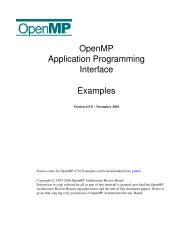D2 3 Computing e-Infrastructure cost calculations and business _models_vam1-final
D2 3 Computing e-Infrastructure cost calculations and business _models_vam1-final
D2 3 Computing e-Infrastructure cost calculations and business _models_vam1-final
Create successful ePaper yourself
Turn your PDF publications into a flip-book with our unique Google optimized e-Paper software.
e-‐FISCAL: www.efiscal.eu <br />
EC Contract Number: 283449 <br />
2009; Hammond et al., 2010; Microsoft, 2010; Kim et al., 2009), papers that discuss the migration to the Cloud <br />
(Misra <strong>and</strong> Mondal, 2011), industry benchmarks (Crosswell, 2010), case studies (Hyak operating <strong>cost</strong>s 32 ) etc. <br />
All papers reviewed are found on the project’s state-‐of-‐the art repository (http://www.efiscal.eu/state-‐of-‐the-‐art). <br />
The repository contained as of 31/1/2013 50 references. <br />
3.2 e-FISCAL <strong>cost</strong>ing model characteristics<br />
The thorough state of the art review provided useful input to develop the <strong>cost</strong>ing model in at least two <br />
dimensions. Firstly, we had to decide on the <strong>cost</strong> categories to be included in the analysis <strong>and</strong> secondly on the <br />
<strong>cost</strong>ing methodology. As for the <strong>cost</strong> categories we decided to abide by the <strong>cost</strong> categorizations proposed by <br />
Optiz et al. (2008). This <strong>cost</strong> categories could be considered as st<strong>and</strong>ard in relevant <strong>cost</strong> studies. As for the <strong>cost</strong>ing <br />
methodology, we built a hybrid <strong>cost</strong>ing model that capitalises on Total Cost of Ownership (TCO) <strong>and</strong> the Full Cost <br />
Accounting (FCA) methodology properly adjusted to the characteristics of the project. <br />
3.2.1 Costing methodology<br />
The hybrid methodology developed for the scope of the project is suitable to calculate the total yearly <strong>cost</strong> of <br />
computing e-‐<strong>Infrastructure</strong>s. Its materialization requires a two-‐step process: a) Simulation of the physical <br />
infrastructure <strong>and</strong> b) Development of the financial model. <br />
a) Simulation of the physical infrastructure: This corresponds to the investment <strong>cost</strong> of the infrastructure which <br />
is approximated by taking into account the capacity in terms of cores, of storage devices, of interconnection <br />
devices <strong>and</strong> of auxiliary equipment <strong>and</strong> the actual purchase values of these elements. <br />
b) Development of the financial model: The financial model is based on two pillars. The annualised <strong>cost</strong> of the <br />
simulated physical infrastructure <strong>and</strong> the operating <strong>cost</strong> of the physical infrastructure. <br />
• The annualized <strong>cost</strong> of the simulated physical infrastructure is derived by applying depreciation rates to <br />
annualise the <strong>cost</strong> of the physical infrastructure simulated in the first step. This amount accounts for the <br />
yearly CAPEX (Capital expenditures). <br />
• The operating <strong>cost</strong> of the physical infrastructure corresponds to the yearly <strong>cost</strong>s for running the <br />
site/centre. In order to approximate the running <strong>cost</strong>, information about the operating <strong>cost</strong>s is gathered <br />
per <strong>cost</strong> category (e.g. personnel <strong>cost</strong>s, electricity, premises <strong>cost</strong>, etc.). This amount accounts for the <br />
OPEX (operating expenses). <br />
More specifically, the <strong>cost</strong> categories that are included are as follows: <br />
1. <strong>Computing</strong> <strong>and</strong> storage hardware <strong>cost</strong>s. This category refers to CPU cores (<strong>and</strong> corresponding boxing), <br />
storage devices (disk <strong>and</strong> tape storage facilities) <strong>and</strong> related interconnect equipment (network devices). <br />
Service support <strong>cost</strong>s fall in this category. <br />
2. Auxiliary equipment <strong>cost</strong>s, that correspond to the investment in cooling devices (air or liquid cooling), <br />
UPSs, power generators, power transformers, etc. <br />
32 http://escience.washington.edu/get-‐help-‐now/hyak-‐operating-‐<strong>cost</strong>s-‐<strong>and</strong>-‐comparison-‐commercial-‐alternatives<br />
e-‐FISCAL : Financial Study for Sustainable <strong>Computing</strong> e-‐<strong>Infrastructure</strong>s <br />
Deliverable <strong>D2</strong>.3 – <strong>Computing</strong> e-‐<strong>Infrastructure</strong>s <strong>cost</strong> estimation <strong>and</strong> analysis – Pricing <strong>and</strong> <br />
Business <strong>models</strong> <br />
33




